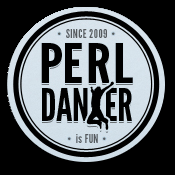All about Dancer – interview of Sawyer X
 After we looked into Catalyst, we continue our exploration of Perl’s land of Web Frameworks, with Dancer.
After we looked into Catalyst, we continue our exploration of Perl’s land of Web Frameworks, with Dancer.
We talk about it to one of the core devs, Sawyer X, who kindly answered our questions in a very detailed and explanatory way, rendering the interview enjoyable and comprehensible even by non techies.
The interview, which spans three parts (to be published weekly), did not stop there however; we also asked his opinion and knowledge on finer grained aspects of the craft that is developing for the Web, such as what the advantage of routing over query strings is, MVC vs Routes, Perl vs PHP vs Ruby, and why CGI.pm must die!
NV:The term might be overloaded, but is Dancer a MVC or should I say a “Route” based framework ? what’s the difference?
SX:Usually MVC frameworks are defined by having a clear distinction between the model (your data source, usually a database), the view (your display, usually a template), and the controller (your application code).
While Dancer helps you to easily separate them (such as providing a separate directory for your templates called “views”, by default), it doesn’t go as far as some other frameworks in how much it confines you to those conventions.
I like to describe Dancer as “MVC-ish”, meaning it has a very clear notion of MVC, but it isn’t restrictive. If you’re used to MVC, you will feel at home. If you’re not, or don’t wish to have full-fledged MVC separation, you aren’t forced to have such either.
Most web frameworks use – what I would call – namespace-matching, in which the path you take has an implicit translation to a directory structure, a function, and the optional arguments. For example, the path /admin/shop/product/42 implicitly states it would (most likely) go to a file called Admin/Shop.pm, to a function called product, and will provide the parameter 42 to the function. The implicit translation here is from the URL /admin/shop/product/42 to the namespace Admin::Shop::product, and 42 as the function parameter.
Route-based frameworks declare explicitly what code to run on which path. You basically declare /admin/shop/product/$some_id will run a piece of code. Literally that is it. There is no magic to describe since there is no translation that needs to be understood.
NV:What is the advantage of routing and why the traditional model of query strings is not enough?
SX:The route-based matching provides several essential differences:
- It is very simple for a developer to understand
- It takes the user perspective: if the user goes to this path, run this code
- It stays smaller since it doesn’t require any specific structure for an implicit translation to work, unlike namespace-matching
The declarative nature of route-based frameworks are quite succinct and dictate which code to run when. As explained, you are not confined to any structure. You can just settle for a single line:
get ‘/admin/shop/product/:id’ => sub {…}
This provides a lot of information in a one line of code. No additional files, no hierarchy. It indicates we’re expecting GET requests which will go to /admin/shop/product/:id. The :id is an indication that this should be a variable (such as a number or name), and we want it to be assigned the name id so we could then use it directly. When that path is reached, we will run that subroutine. It really is that simple. We could reach that variable using a Dancer keyword, specifically param->{‘id’}.
NV:Dancer is a complete feature-rich DSL. Does this mean that I write code in a dedicated language and not Perl?
SX:All the web layer done through Dancer can be done in the DSL, but the rest of your application is done in Perl. Dancer just provides a comfortable, clean, beautiful language to define your web layer and to add parts to it (like cookies, different replies, template rendering, etc.). In Dancer2 the DSL is built atop a clean object-oriented interface and provides nice keywords to it.
That is really what a web framework should do: provide a nice clean layer on top of your application.
I guess a better way would be to say you write your code in Perl with dedicated functions that look nicer. :)
NV:There are many web frameworks out there each one targeting various “problem” areas of web development. Which ones does Dancer address?
Dancer provides a sane thin layer for writing stable websites. It introduces relatively few dependencies, but doesn’t reinvent everything. It uses sane defaults and introduces basic recommended conventions, but isn’t too opinionated and remains flexible in the face of a multitude of use cases.
NV:What about the other Perl frameworks, Catalyst and Mojolicious? How do they compare to Dancer?
SX:Catalyst, as great a framework as it is, is pretty big. It uses an enormous amount of modules and clearly very opinionated. This is not necessarily a bad thing, but it might not be what you’re interested in.
Mojolicious pushes the boundaries of HTML5 programming, proving all the eye-candy features HackerNews buzzes about, and is very successful at that.
Dancer fills in the niche between those. It provides a stable base for your website. It does not depend on as many modules, but it does not reinvent every single wheel in existence. It’s the “oh my god, this is how my production websites now look like!” call of gleeful cheer. :)
Nikos Vaggalis has a BSc in Computer Science and a MSc in Interactive Multimedia. He works as a Database Developer with Linux and Ingres, and programs in both Perl and C#. He writes articles, conducts interviews and reviews technical IT books

Thanks for the article. My first experience with routing wasn’t with Perl but with Nodejs, but as a Perl newbie this is great information.